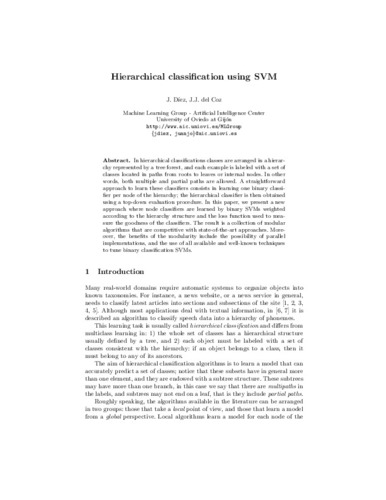Hierarchical classification using SVM
Autor(es) y otros:
Fecha de publicación:
Editorial:
Asociación Española para la Inteligencia Artificial
Descripción física:
Resumen:
In hierarchical classi cations classes are arranged in a hierar- chy represented by a tree forest, and each example is labeled with a set of classes located in paths from roots to leaves or internal nodes. In other words, both multiple and partial paths are allowed. A straightforward approach to learn these classi ers consists in learning one binary classi- er per node of the hierarchy; the hierarchical classi er is then obtained using a top-down evaluation procedure. In this paper, we present a new approach where node classi ers are learned by binary SVMs weighted according to the hierarchy structure and the loss function used to mea- sure the goodness of the classi ers. The result is a collection of modular algorithms that are competitive with state-of-the-art approaches. More- over, the bene ts of the modularity include the possibility of parallel implementations, and the use of all available and well-known techniques to tune binary classi cation SVMs
In hierarchical classi cations classes are arranged in a hierar- chy represented by a tree forest, and each example is labeled with a set of classes located in paths from roots to leaves or internal nodes. In other words, both multiple and partial paths are allowed. A straightforward approach to learn these classi ers consists in learning one binary classi- er per node of the hierarchy; the hierarchical classi er is then obtained using a top-down evaluation procedure. In this paper, we present a new approach where node classi ers are learned by binary SVMs weighted according to the hierarchy structure and the loss function used to mea- sure the goodness of the classi ers. The result is a collection of modular algorithms that are competitive with state-of-the-art approaches. More- over, the bene ts of the modularity include the possibility of parallel implementations, and the use of all available and well-known techniques to tune binary classi cation SVMs
Descripción:
XIII Conferencia de , XIII Conferencia de la Asociación Española para la Inteligencia Artificial, CAEPIA–TTIA 2009, Sevilla, 9–13 de Noviembre de 2009
ISBN:
Patrocinado por:
The research reported in this paper has been supported in part under Spanish Ministerio de Educaci on y Ciencia (MEC) grant TIN2008-06247
Colecciones
- Capítulos de libros [6535]
- Informática [875]
- Investigaciones y Documentos OpenAIRE [8420]
Ficheros en el ítem




